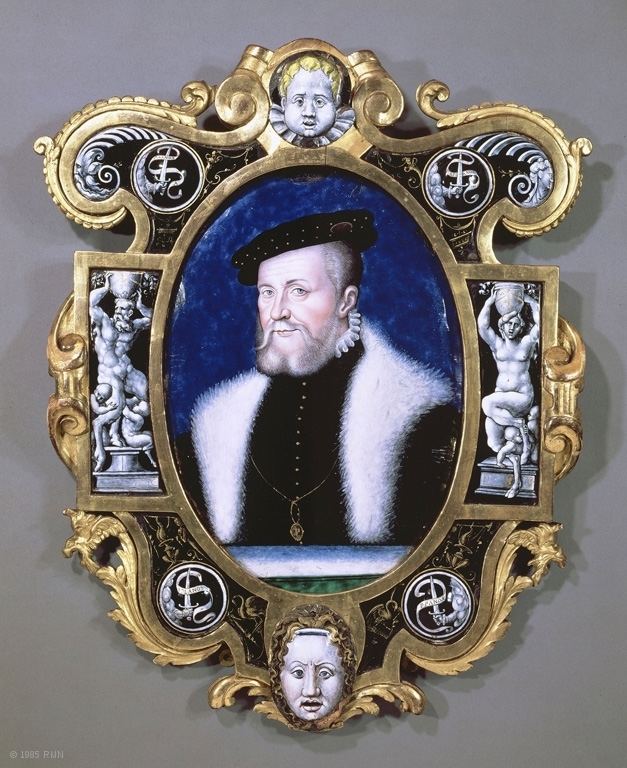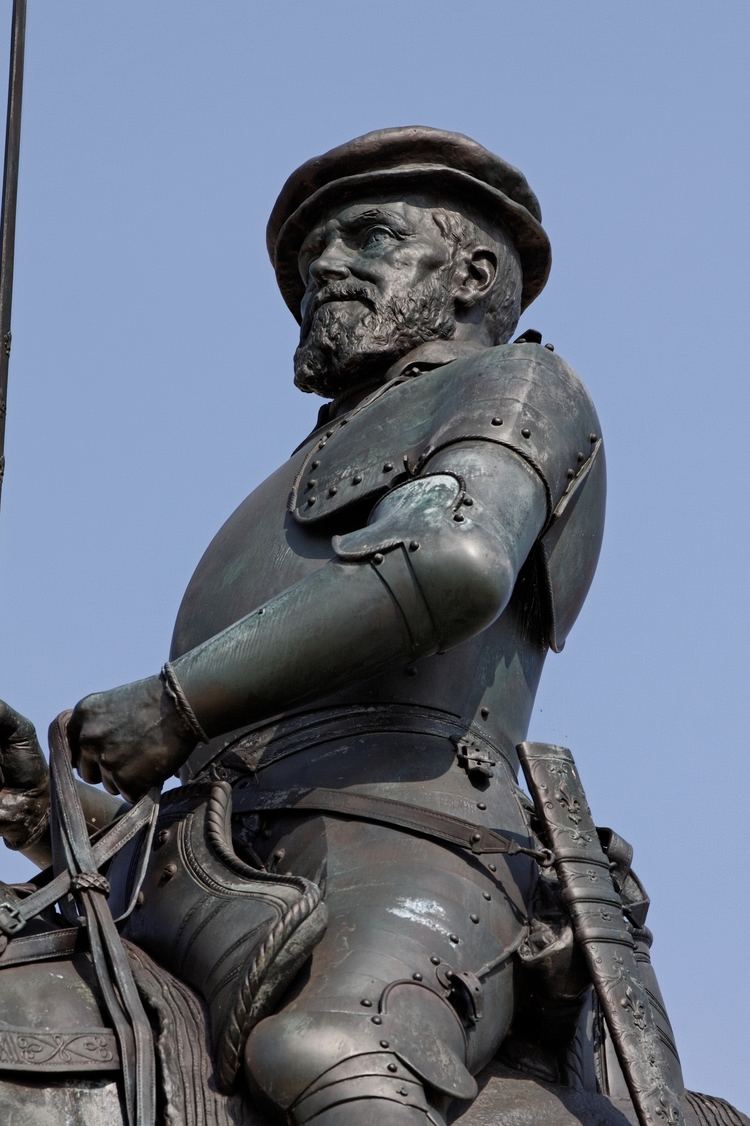Spouse(s) Madeleine of Savoy Siblings Louise de Montncy Name Anne Montmorency | Mother Anne Pot Noble family Montmorency family | |
 | ||
Father Guillaume de Montmorency Born 15 March 1493Chantilly ( 1493-03-15 ) Children Francois de Montncy, Henri I de Montncy Grandchildren Charlotte Marguerite de Montncy Similar People Francois de Montncy, Charlotte Marguerite de Montm, Henry II of France, Gaspard II de Coligny, Francis I of France | ||
Anne de montmorency sa vie son oeuvre son beau frere
Anne, Duke of Montmorency, Honorary Knight of the Garter (15 March 1493, Chantilly, Oise – 12 November 1567, Paris) was a French soldier, statesman and diplomat. He became Marshal of France and Constable of France.
Contents
- Anne de montmorency sa vie son oeuvre son beau frere
- Spectacle renaissance chateau d ecouen anne de montmorency
- Early life
- Reign of Francis I
- Henry II
- Francis II
- French Wars of Religion
- Death
- Children
- References

Spectacle renaissance chateau d ecouen anne de montmorency
Early life

Montmorency was born at Chantilly to the ancient Montmorency family. His father, Guillaume, had a senior status in the household of Francis, Count of Angoulême (the future King Francis I). He was raised beside Francis and they became close, fighting together in 1512 at the Battle of Ravenna.

In 1514 his sister Louise de Montmorency married Gaspard I de Coligny. Their children included Gaspard II de Coligny who was Admiral of France (Amiral de Coligny), Odet, cardinal de Châtillon and François. Gaspard II had a daughter Louise who married William the Silent (William I, Prince of Orange).
Reign of Francis I

When Francis acceded to the throne in January 1515, Montmorency became an influential member of his court. When the king reasserted the French claim to Milan the same year, Montmorency followed his king into Italy and distinguished himself at Marignano.

Montmorency was named captain of the Bastille in 1516 and became governor of Novara. In 1518 he was one of the hostages in England for Francis I's debt to Henry VIII for the city of Tournai. He returned to France to attend a short and unsuccessful peace conference between the French and the Holy Roman Empire in May 1519. The following year he was present at the Field of the Cloth of Gold and afterwards had charge of diplomatic negotiations in England when relations between the two countries again began to sour.

In August 1521, Montmorency helped to command the defence of Mézières against the Imperial German army. In the same year he commanded the Swiss in Italy. His troops were defeated in the Battle of La Bicocca on 27 April 1522, but he was made Marshal of France in recognition of his courage.

Montmorency spent the next three years defending northern France against the English invasion of 1523. By that time England had allied with the Holy Roman Empire. In 1524 he again joined Francis I in a campaign to retake Milan. On 24 February 1525, an army of Italians, Spanish and Germans defeated the French at the Battle of Pavia and captured both de Montmorency and his king. Both were sent to Spain but Montmorency was released soon afterwards. He was one of the negotiators of the Treaty of Madrid in 1526 and attended his king when he was exchanged for his two eldest sons. In 1530 he returned the king's sons to France.

On 23 March 1526, Anne de Montmorency was named Grand Master of France charged with supervision of the royal household and the king's private service. In 1527 he married Madeleine, the daughter of René of Savoy. He supported the king's efforts to form an alliance against Charles V. He worked with Cardinal Wolsey to form an alliance between Francis I and Henry VIII in 1527. This led to a new war against the Holy Roman Empire that ended with the Peace of Cambrai.

In 1536, Francis I invaded the Duchy of Savoy, against the advice of Montmorency, staking claim to the lands of the duchy but also to pressure Charles V to give Milan back to him. Charles V invaded Provence from Northern Italy in retaliation. Francis appointed Montmorency, who had now retired from the court, to be the governor of Languedoc, the lieutenant general in the southeast of France and they led the defence of Provence using scorched earth tactics. Montmorency evacuated Aix-en-Provence and concentrated his forces near Avignon. By the early autumn Charles V had been forced to retreat his army to Genoa and lift the siege of Marseille.
Montmorency joined the king in Picardy and at the end of the Netherlands campaign marched to relieve Turin. He led the French troops in 1537 when they attacked Artois in the Netherlands and captured many towns before the ten-year truce. On 10 February 1538 the king made him Constable of France.
Afterwards Montmorency begun to support peace with the Holy Roman Emperor, against the prevailing attitude of the court. He renewed negotiations with the Holy Roman Empire and encouraged the Pope Paul III to create a settlement. He managed to get the two kings to meet at Aigues-Mortes in July 1538. According to the deal he had brokered, Francis expected that Charles V would give Milan to one of Francis' sons as a sign of alliance, but Charles gave the title to his son Philip.
This result was a diplomatic failure and de Montmorency fell out of royal favor. Francis I turned to his rivals Cardinal Tournon, Claude d'Annebault and his mistress Anne de Pisseleu d'Heilly, the Duchess of Étampes. Montmorency retired from court in June 1541. Having lost his post as a governor of Languedoc, he was forbidden to exercise his other offices. He continued to maintain correspondence with the prince Henry.
Henry II
Montmorency did not return to public life until the accession of Henry II in March 1547. The new king gave him back all his former offices and dismissed the duchesse d'Étampes and her followers. In 1548 Montmorency crushed the insurrections in the southwest, particularly at Bordeaux. From 1549-50 Montmorency led the war in the Boulonnais, negotiating the treaty for the surrender of Boulogne on 24 March 1550. As a reward the king created him a duke and peer of France and in 1551 his barony was expanded into a duchy. Soon afterwards his armies fought in the northeast when the French army seized Metz, Toul and Verdun.
Francis II
Montmorency's attempt to relieve St Quentin on 10 August 1557 led to his defeat and capture by Spanish Habsburg forces. He was not released until October 1558 at the Peace of Cateau-Cambrésis. By this time the Guises had supplanted him and the 15-year-old king Francis II treated him with indifference. Montmorency had to give up his Great Master status to the Duke of Guise. However, his son was appointed marshal by way of indemnity. He himself retired to his estates.
French Wars of Religion
On the accession of Charles IX in 1560 Montmorency again assumed his duties in the court. However, when the Protestant-minded House of Bourbon asserted influence over the young king, the Roman Catholic Montmorency left the court. In April 1561 he allied himself with Francis, Duke of Guise, his former enemy, and Jacques d'Albon, Marshal Saint-Andre to form the Triumvirate, an association for the defense of Catholicism.
Montmorency played an important part in the war of 1562. He was captured early in the Battle of Dreux when the cavalry under him was routed. Montmorency's soldiers eventually won the battle, but it was one of the bloodiest of the 16th century. He helped negotiate the Treaty of Amboise on 19 March 1563. In 1567 the Huguenots agitated for a fairer settlement.
Death
On 10 November 1567, aged 74, Montmorency led the royal army to victory at Saint-Denis, but was fatally wounded and died two days later.
Children
His marriage produced twelve children:
